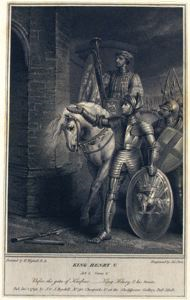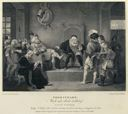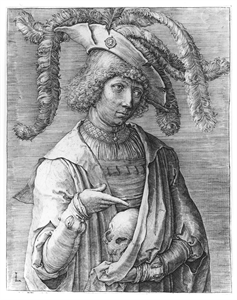
John Boydell
English, 1719–1804
Josiah Boydell (aka Joshua Boydell)
English, 1752–1817
James Stow
English, about 1770–after 1820
after Richard Westall
English, 1765–1836
From Boydell's Graphic Illustrations of the Dramatic Works of Shakespeare
In 1786, a successful London publisher, alderman John Boydell, conceived of a gallery of art devoted to scenes from Shakespeare’s plays. Named for its founder, the Boydell Shakespeare Gallery was one of the first large-scale commercial endeavors intended to promote British literature and artists both in Great Britain as well as throughout the European continent. He commissioned over 167 paintings of scenes from Shakespeare’s plays and produced engravings based on these paintings. In creating the engravings, John Boydell partnered with his son, Josiah, whose name appears after his father’s in the list above. The third name is that of the engraver, and the fourth is that of the painter who created the original composition in oils. The role of the engraver was to transfer the painter’s composition onto plates for printing.
About this scene:
The “wild” Prince Hal matures into a talented politician, an heroic general, and a king who means to redeem his father’s seizure of the crown. Proclaiming his genealogical right to the French throne, Henry’s army besieges Harfleur. He rouses his troops with patriotic appeal, then threatens the desperate city with rapine, murder, and destruction to gain its submission. After Harfleur surrenders, seen here, he charges his kinsman Exeter to govern the city with mercy, as Henry intended, despite his threats.
The outraged French nobles intend to crush him as he marches across northern France, and, vastly outnumbered at Agincourt, Henry prays God’s mercy on his men, calls them his brothers, and invokes how they will be remembered—as they are, since they achieved one of history’s greatest upset victories. Henry then wins the French princess’s hand and promise of the French crown, though he will die only weeks before inheriting it.
-Susan Willis, dramaturg, Alabama Shakespeare Festival, September 28, 2020
English, 1719–1804
Josiah Boydell (aka Joshua Boydell)
English, 1752–1817
James Stow
English, about 1770–after 1820
after Richard Westall
English, 1765–1836
King Henry V, Act 3, Scene 3
about 1804From Boydell's Graphic Illustrations of the Dramatic Works of Shakespeare
Object Type:
Print
Dimensions:
10 11/16 x 6 9/16 in. (27 x 17 cm)
Medium and Support:
Engraving on paper
Accession Number:
2016.0008.0012
Credit Line:
Gift of Dora Kaufman Nelke, by exchange
In 1786, a successful London publisher, alderman John Boydell, conceived of a gallery of art devoted to scenes from Shakespeare’s plays. Named for its founder, the Boydell Shakespeare Gallery was one of the first large-scale commercial endeavors intended to promote British literature and artists both in Great Britain as well as throughout the European continent. He commissioned over 167 paintings of scenes from Shakespeare’s plays and produced engravings based on these paintings. In creating the engravings, John Boydell partnered with his son, Josiah, whose name appears after his father’s in the list above. The third name is that of the engraver, and the fourth is that of the painter who created the original composition in oils. The role of the engraver was to transfer the painter’s composition onto plates for printing.
About this scene:
The “wild” Prince Hal matures into a talented politician, an heroic general, and a king who means to redeem his father’s seizure of the crown. Proclaiming his genealogical right to the French throne, Henry’s army besieges Harfleur. He rouses his troops with patriotic appeal, then threatens the desperate city with rapine, murder, and destruction to gain its submission. After Harfleur surrenders, seen here, he charges his kinsman Exeter to govern the city with mercy, as Henry intended, despite his threats.
The outraged French nobles intend to crush him as he marches across northern France, and, vastly outnumbered at Agincourt, Henry prays God’s mercy on his men, calls them his brothers, and invokes how they will be remembered—as they are, since they achieved one of history’s greatest upset victories. Henry then wins the French princess’s hand and promise of the French crown, though he will die only weeks before inheriting it.
-Susan Willis, dramaturg, Alabama Shakespeare Festival, September 28, 2020
Keywords
Click a term to view the records with the same keyword
Related Objects
Click a record to view

Tempest, Act 1, Scene 2
2016.0008.0001

Merry Wives of Windsor, Act 5, Scene 5
2016.0008.0002

Much Ado About Nothing, Act 4, Scene 2
2016.0008.0003

Midsummer-Night’s Dream, Act 2, Scene 1
2016.0008.0004

Merchant of Venice, Act 3, Scene 2
2016.0008.0005

Taming of the Shrew, Act 4, Scene 5
2016.0008.0006

Twelfth Night, Act 2, Scene 3
2016.0008.0007

Macbeth, Act 1, Scene 3
2016.0008.0008

Macbeth, Act 5, Scene 1
2016.0008.0009

King Richard II, Act 3, Scene 2
2016.0008.0010

King Henry IV, Part 1, Act 2, Scene 1
2016.0008.0011

King Henry VI, Part 1, Act 5, Scene 4
2016.0008.0013

King Richard III, Act 3, Scene 1
2016.0008.0014

Antony and Cleopatra, Act 4, Scene 4
2016.0008.0015

Romeo and Juliet, Act 3, Scene 5
2016.0009.0001

Hamlet, Act 3, Scene 4
2016.0009.0002

Hamlet, Act 4, Scene 7
2016.0009.0003
Portfolio List
Click a portfolio name to view all the objects in that portfolio
This object is a member of the following portfolios:
Your current search criteria is: Keyword is "SZ" and [Object]Century is "Nineteenth Century" and [Object]Display Artist is "John Boydell".
